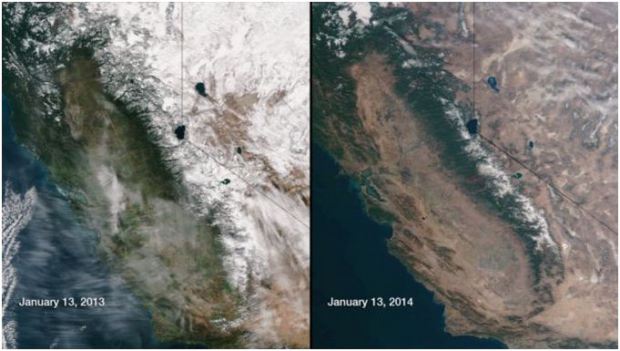 Satellite image showing effect of California Drought, via NASA
Satellite image showing effect of California Drought, via NASA
Drought Threatens Food Security
Food security is one of the most basic forms of security that a state needs to survive. Climate change presents a threat to global food security, and a recent study has shown that the U.S.’ food security is already being negatively impacted by climate change. The study, published in Geophysical Research Letters, concluded that 8-27% of the California drought is attributable to climate change. This marks one of the rare times where climate change can be said to have a directly contributed to a climate event, rather than merely increasing its probability.
The reason for this direct link is due to the fact that hotter air is able to hold more water vapor. The more temperatures rise, the more water will be in the air and less in the ground. California’s agricultural industry is being hit hard by the drought, with an economic impact estimated at $2.2 billion and 17,000 jobs. Potentially even worse is that California only has a year’s supply of water in its reservoirs, and is relying on groundwater at an unsustainable rate in order to make up the difference. If the drought continues to worsen, the impact on California’s agricultural industry (which produces the vast majority of the U.S.’ fruits and vegetables) would be far more serious. The drought may be the focus of U.S. attention now, but the impact of climate change on food security will be felt globally. The conflict in Syria has its roots in the food insecurity caused by a serious drought, one that was made 2 to 3 times more likely as a result of climate change.
These droughts are highlighting the primary threat climate change poses to food security, which comes in the form of extreme occurrences. Initial predictions by the USDA showed that overall agricultural production would be relatively unaffected by climate change, with some areas producing more or less food. However, more recent studies that have taken into account the impact of increased evaporation have shown that the prevalence of droughts is likely to increase, particularly in key agricultural regions.
As the global population rises, food demand will rise as well. Population rises will not be the same everywhere though, and ironically some of the most food insecure regions will be the ones to experience the largest population growth. This will affect American interests as global food prices are affected by the events abroad as well as at home, and will also be a source of instability globally. The drought in California is not merely Americans experiencing climate change, it is the beginning of a global climate trend that scientists are only predicting will worsen.





